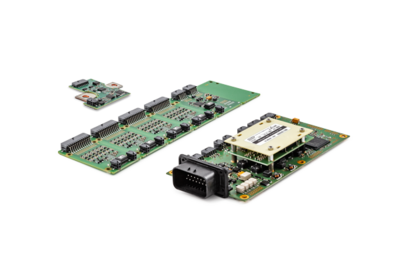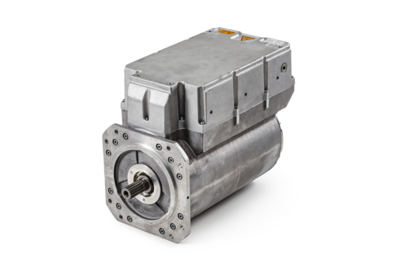The e-machines in the powerMELA product family by Sensor-Technik Wiedemann GmbH (STW) are recommended for very different applications. They can be used in the diesel-electric PistenBully 600 E+ by Kässbohrer just as in the Green-Tech robot – a shunting locomotive produced by Vollert. Having been used in numerous fields, the machine has now also been developed for water applications. Here, the diesel-electric drive is an established solution: A diesel engine supplies the energy whilst the electric driveline ensures optimum load distribution and speed. This configuration has proven particularly flexible in the case of ships with several propellers and high requirements on maneuverability.
Now STW has taken the next step. For the first time, a hybrid drive has been developed for a passenger ship with two completely independent energy storages and engines: The diesel main drive is now assisted by a battery-electric auxiliary drive as a maneuvering aid and emergency drive. Zebotec GmbH from Constance has assembled an innovative electric drive unit from STW key components, which functions as a 360° bow thruster and can also move the entire ship on its own.
The ship
The passenger ship “Bohemia Rhapsody”, constructed at the Bolle shipyard Derben in Saxony-Anhalt, is 45 meters long, displaces 123 tons of water and offers space for 220 passengers.
The predecessor to this ship is only one year its senior and is called the Aqua Cabrio "Grand Bohemia". This ship, with its emission-reduced diesel drive and an electrically-operated transverse thruster was up to now considered a great milestone. Now the “Bohemia Rhapsody” with its innovative drive shows how the ecological added value and the economic benefits can be further increased. This ship is substantially larger again, and has an appropriately powerful main drive of 166 kW, which accelerates the ship to up to 20 km/h. The transverse thruster has been replaced through a thrust vector control. The “Bohemia Rhapsody” was put into operation as planned for the 2015 season and is now used on the Moldau (Vltava) by PRAGUE BOATS. Its native harbor of Kampa lies in the center of the capital city of Prague and thus represents a location in which its ecological footprint enjoys great public attention. The shipping companies react to this public interest with innovative ships such as the “Bohemia Rhapsody”.
Planning and design
As the river and the harbors no longer offer sufficient space for larger ships to maneuver in, it quickly became clear that a smarter maneuvering aid would be required for such a big ship. A 360° pump jet has therefore now replaced the transverse thruster on the predecessor model. The pump jet generates a thrust vector in any direction and thus not only assists the ship when turning, but also permits it to drive straight ahead and astern. The authorities responsible for the certification were also focusing on an increase in operating safety. They demanded a completely independent, redundant drive with its own energy source. Therefore it made sense to combine this auxiliary drive with the pump jet.
The idea of installing a second diesel engine with a second tank was quickly rejected. From the perspective of the emission reductions strived for, this would have been more of a setback. The approach, which involved the installation of an electric drive with battery proved to be the far better option. Only this combination would be in a position to keep the emissions low and yet fulfill the specific characteristics of the pump jet.
Due to the specified installation space and the lifetime length desired, only state of the art components came into question for the battery and the e-machine. Zebotec GmbH has dedicated itself completely to emission-free boat drives and has already for years featured a modular lithium-ion battery in its range with the STW Battery Management System mBMS, which can be configured to high voltages and, depending on requirements, also to the required power and energy content. In comparison to a lead-acid battery, this system represents the more economic solution long-term. It is maintenance-free, permits larger unloading strokes and better degrees of efficiency. In addition, it is substantially more lightweight and compact. The drive should be a permanently-excited synchronous machine (PSM) with integrated inverter – and a powerMELA-C 140,also from the STW range, proved to be the ideal solution.
After practical testing, the SUK (Ship Investigation Committee) stipulated for the “Bohemia Rhapsody” a purely electrical operating time of 30 minutes with a mean capacity of 60 kW. This energy reserve is intended to keep the ship maneuverable in cases of emergency, and also to remove it safely from the fairway in case the main drive fails. The installed battery covers this requirement without any trouble. It consists of two redundant lines of 26 kWh each. In this way, it is possible to drive almost double as long with the required power. The pump jet performs maximum 75 kW, a value which neither the battery nor the electrical machine really demand.
System integration
The e-machine and the energy storages represent the key components, and the collective 650 Volt nominal voltage determines the selection of all further components. Diverse voltage transformers are required: DC/DC, DC/AC and AC/DC, as the ship has numerous power networks with very different characteristics. In addition to a 230 Volt AC power network, from which the battery is recharged with maximum 50 kW and which can also be supported from the battery, there is a 24 Volt DC power network, which supplies the on-board electronics. The steering hydraulics and the circulation pump for the e-machine coolant are supplied from a separate 230 Volt AC power network. For reasons of functional safety, this is an independent network which has no direct connection to the other AC power network on the ship. It is fed from the lithium-ion battery and thus permits energetic autonomy in purely electrical driving operation.
The autonomy of the auxiliary drive is a design principle which runs through the entire drive architecture. It leaves its traces in the engine room of the “Bohemia Rhapsody” and also on its bridge. Completely separate operating elements and separate control electronics make it clear to the helmsman that they can really drive the ship using two completely independent drives.
Summary
The operator is proud of his new flagship and refers in particular to the low-vibration maneuvering operation at the pier. An unimaginable range of further possibilities becomes feasible in practical driving operation. As an energy reserve is for the first time made available through the battery, the diesel engine can work far more frequently in the partial-load range, although the ship has full power at its disposal. This saves the diesel engine being subjected to abrupt load changes, which it would acknowledge only through substantial exhaust gas emissions. Up until now, these emissions have been considered unavoidable – to the detriment of the passengers and the inhabitants of the city.
All these advantages played a subordinate role at the start of the project. Only during the course of this project did it become clear that initially the safety would be increased, and therefore that an autonomous, redundant drive should be introduced. The fact that an electric drive in particular would also provide further ecological advantages convinced the decision-makers and made them decide in favor of a battery-electrical solution. The remaining time to implementation was tight; but the system integrator zebotec remained optimistic, as they knew they could rely on key components from the STW range.
“The fact that the project could be implemented within a few months is thanks to the maturity and compatibility of the STW components”, emphasizes Richard Morris from zebotec. STW supplied the Battery Management System mBMSfor the lithium-ion batteries and the e-machine powerMELA-C 140.
Dietmar Schrägle from STW added: “This drive solution, which works without external engines, is unique in this form. In addition, the hybrid application involving a conventional diesel engine and an energy-efficient electric drive makes a direct contribution towards environmental protection”.
For the Bolle shipyard, fitting a ship with such a system was something completely new. Therefore they are all the more surprised by the simplicity of the installation. The hybrid electric ship’s drive will from now be planned into subsequent projects, and further electrification and hybridization of the energy systems on ships can now be developed: a diesel-electric main drive with energy recovery; the use of regeneratively-generated electricity, which is either generated on the vehicle itself or can be “topped up” from land-based sources at the pier.



